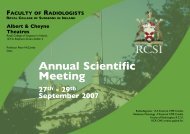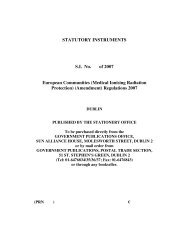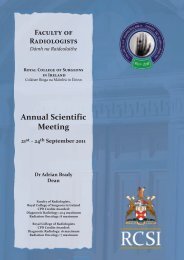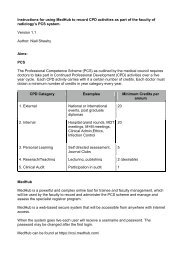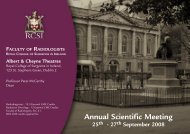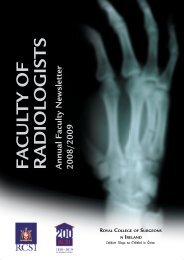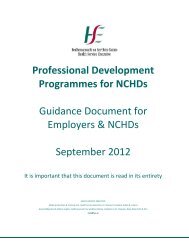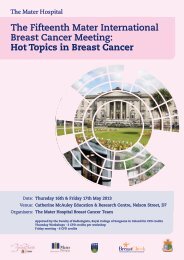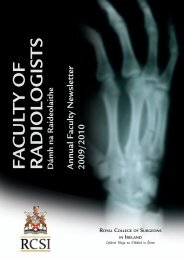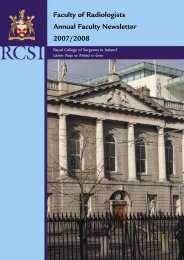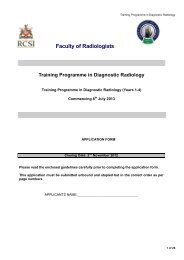Annual Report 2011-2012 - Faculty of Radiologists
Annual Report 2011-2012 - Faculty of Radiologists
Annual Report 2011-2012 - Faculty of Radiologists
Create successful ePaper yourself
Turn your PDF publications into a flip-book with our unique Google optimized e-Paper software.
European Board <strong>of</strong> Radiology<br />
The European Board <strong>of</strong> Radiology was inaugurated<br />
following decision <strong>of</strong> the Executive Council <strong>of</strong><br />
European Society <strong>of</strong> Radiology in 2010. The logic<br />
for creating such a new body was the acknowledged<br />
necessity to create a distinct body which would<br />
evaluate standards <strong>of</strong> radiologic knowledge, and<br />
accreditation <strong>of</strong> educational facilities in radiology on<br />
a Europe-wide level. In addition it was conceived<br />
that this body would assist individual radiologists by<br />
providing CME evaluation <strong>of</strong> international scientific<br />
meetings, and distance learning programmes. The<br />
necessity to structurally and administratively separate<br />
such evaluations from the provision <strong>of</strong> facilities is in<br />
line with evolving international practice.<br />
The European Board <strong>of</strong> Radiology is led by a<br />
Scientific Director who chairs the Scientific Board.<br />
Shareholders for the new legal entity include<br />
the President, First Vice-President, Second Vice-<br />
President and Past President <strong>of</strong> the European Society<br />
<strong>of</strong> Radiology. A number <strong>of</strong> committees report to the<br />
Board on specific activities which heret<strong>of</strong>ore have<br />
mainly related to development and enhancement <strong>of</strong><br />
the diploma project.<br />
The first European Diploma in Radiology examination<br />
was held in Vienna coinciding with ECR <strong>2011</strong>. A<br />
programme <strong>of</strong> annual examinations coinciding with<br />
ECR, together with examination episodes at national<br />
meetings <strong>of</strong> major European countries has now<br />
been instituted. Strict eligibility criteria apply, and<br />
the examination is open to candidates in the last<br />
year <strong>of</strong> training. The examination consists <strong>of</strong> three<br />
components, a multiple choice section, a short case<br />
section to include interpretation <strong>of</strong> normal and<br />
abnormal imaging, and an oral component consisting<br />
<strong>of</strong> 20 x 5 minute sessions with two sets <strong>of</strong> examiners.<br />
<strong>Annual</strong> <strong>Report</strong>s <strong>of</strong> Committees <strong>2011</strong>/<strong>2012</strong><br />
22<br />
European Affairs<br />
The examination is web-based, and based on the<br />
knowledge requirements as set out in the revised<br />
European Charter and Curriculum. Example multiple<br />
choice questions and case material are available on<br />
the EBR website. The language <strong>of</strong> the examination<br />
is English, though where the examination is<br />
conducted in association with the annual congress<br />
<strong>of</strong> major international societies, facilities to take<br />
the oral examination in the local language would be<br />
facilitated.<br />
Close co-operation with national societies, and<br />
national educational and examination structures<br />
are already in existence, and I acknowledge<br />
with thanks our Dean, Dr. Adrian Brady, who has<br />
been an enthusiastic support and examiner since<br />
commencement <strong>of</strong> the project. I would also wish<br />
to thank the Board for its support <strong>of</strong> this initiative,<br />
and hope that Irish trainees will see this facility as a<br />
useful educational assessment tool in their personal<br />
career development. By virtue <strong>of</strong> the high quality<br />
case material used, incorporation <strong>of</strong> a technically<br />
sophisticated web-based methodology, and the high<br />
calibre <strong>of</strong> examining personnel, it can be anticipated<br />
that the examination is <strong>of</strong> high reputational merit,<br />
good standard; thus far the pass rate is in the region<br />
<strong>of</strong> 75-80%.<br />
In addition to provision <strong>of</strong> a facility to aid personal<br />
pr<strong>of</strong>essional development, in the context <strong>of</strong> free<br />
migration throughout Europe the examination will<br />
provide an objective standard <strong>of</strong> knowledge and<br />
competence which it is hoped will significantly<br />
assist employing authorities and chairpersons<br />
in establishing candidates’ suitability where the<br />
radiologic educational background may be unknown.




